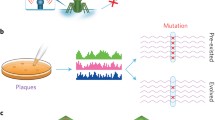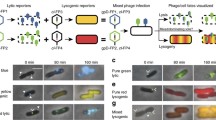Abstract
Optimality models are frequently used to create expectations about phenotypic evolution based on the fittest possible phenotype. However, they often ignore genetic details, which could confound these expectations. We experimentally analyzed the ability of organisms to evolve towards an optimum in an experimentally tractable system, lysis time in bacteriophage T7. T7 lysozyme helps lyse the host cell by degrading its cell wall at the end of infection, allowing viral escape to infect new hosts. Artificial deletion of lysozyme greatly reduced fitness and delayed lysis, but after evolution both phenotypes approached wild-type values. Phage with a lysis-deficient lysozyme evolved similarly. Several mutations were involved in adaptation, but most of the change in lysis timing and fitness increase was mediated by changes in gene 16, an internal virion protein not formerly considered to play a role in lysis. Its muralytic domain, which normally aids genome entry through the cell wall, evolved to cause phage release. Theoretical models suggest there is an optimal lysis time, and lysis more rapid or delayed than this optimum decreases fitness. Artificially constructed lines with very rapid lysis had lower fitness than wild-type T7, in accordance with the model. However, while a slow-lysing line also had lower fitness than wild-type, this low fitness resulted at least partly from genetic details that violated model assumptions.






Similar content being viewed by others
References
Abedon ST (1992) Lysis of lysis-inhibited bacteriophage T4-infected cells. J Bacteriol 174:8073–8080
Abedon ST, Herschler TD, Stopar D (2001) Bacteriophage latent-period evolution as a response to resource availability. Appl Environ Microbiol 67:233–4241
Abedon ST, Hyman P, Thomas C (2003) Experimental examination of bacteriophage latent-period evolution as a response to bacterial availability. Appl Environ Microbiol 69:7499–7506
Bull JJ, Badgett MR, Rokyta D, Molineux IJ (2003) Experimental evolution yields hundreds of mutations in a functional viral genome. J Mol Evol 57:241–248
Bull JJ, Badgett MR, Wichman HA (2000) Big-benefit mutations in a bacteriophage inhibited with heat. Mol Biol Evol 17:942–950
Chang CY, Nam K, Young R (1995) S gene expression and the timing of lysis by bacteriophage lambda. J Bacteriol 177:3283–3294
Charnov EL (1982) The theory of sex allocation. Monogr Popul Biol 18:1–355
Cheng X, Zhang X, Pflugrath JW, Studier FW (1994) The structure of bacteriophage T7 lysozyme, a zinc amidase and an inhibitor of T7 RNA polymerase. Proc Natl Acad Sci USA 91:4034–4038
Dunn JJ, Studier FW (1983) Complete nucleotide sequence of bacteriophage T7 DNA and the locations of T7 genetic elements. J Mol Biol 166:477–535
Engel H, Kazemier B, Keck W (1991) Murein-metabolizing enzymes from Escherichia coli: sequence analysis and controlled overexpression of the slt gene, which encodes the soluble lytic transglycosylase. J Bacteriol 173:6773–6782
Freeland SJ, Knight RD, Landweber LF, Hurst LD (2000) Early fixation of an optimal genetic code. Mol Biol Evol 17:511–518
Garcia LR, Molineux IJ (1996) Transcription-independent DNA translocation of bacteriophage T7 DNA into Escherichia coli. J Bacteriol 178:6921–6929
Hutchinson CA, Sinsheimer RL (1966) The process of infection with bacteriophage phiX174. J. Mol Biol. 18:429–447
Inouye M, Arnheim N, Sternglanz R (1973) Bacteriophage T7 lysozyme is an N-acetylmuramyl-L-alanine amidase. J Biol Chem 248:7247-7252
Josslin R (1970) The lysis mechanism of phage T4: mutants affecting lysis. Virology 40:719–726
Kanamaru S, Ishiwata Y, Suzuki T, Rossmann MG, Arisaka F (2005) Control of bacteriophage T4 tail lysozyme activity during the infection process. J Mol Biol 346:1013–1020
Kao SH, McClain WH (1980a) Baseplate protein of bacteriophage T4 with both structural and lytic functions. J Virol 34:95–103
Kao SH, McClain WH (1980b) Roles of bacteriophage T4 gene 5 and gene s products in cell lysis. J Virol 34:104–107
Kemp P, Gupta M, Molineux IJ (2004) Bacteriophage T7 DNA ejection into cells is initiated by an enzyme-like mechanism. Mol Microbiol 53:1251–1265
Lehman N (2004) Assessing the likelihood of recurrence during RNA evolution in vitro. Artif Life 10:1–22
Lewontin RC (1989) A natural selection. Nature 339:107
Lyakhov DL, He B, Zhang X, Studier FW, Dunn JJ, McAllister WT (1997) Mutant bacteriophage T7 RNA polymerases with altered termination properties. J Mol Biol 269:28–40
McAllister WT, Wu HL (1978) Regulation of transcription of the late genes of bacteriophage T7. Proc Natl Acad Sci USA 75:804–808
Moak M, Molineux IJ (2000) Role of the Gp16 lytic transglycosylase motif in bacteriophage T7 virions at the initiation of infection. Mol Microbiol 37:345–355
Moak M, Molineux IJ (2004) Peptidoglycan hydrolytic activities associated with bacteriophage virions. Mol Microbiol 51:1169–1183
Moffat BA, Studier FW (1987) T7 lysozyme inhibits transcription by T7 RNA polymerase. Cell 49:221–227
Molineux IJ (1999) T7 bacteriophages. In: Creighton TE (ed) Encyclopedia of molecular biology. New York: Wiley. p 2495–2507
Molineux IJ (2001) No syringes please, ejection of phage T7 DNA from the virion is enzyme driven. Mol Microbiol 40:1–8
Nakagawa H, Arisaka F, Ishii S (1985) Isolation and characterization of the bacteriophage T4 tail-associated lysozyme. J Virol 54:460–466
Rennell D, Bouvier SE, Hardy LW, Poteete AR (1991) Systematic mutation of bacteriophage T4 lysozyme. J Mol Biol 222:67–88
Rokyta D, Badgett MR, Molineux IJ, Bull JJ (2002) Experimental genomic evolution: extensive compensation for loss of DNA ligase activity in a virus. Mol Biol Evol 19:230–238
Scholl D, Kieleczawa J, Kemp P, Rush J, Richardson CC, Merril C, Adhya S, Molineux IJ (2004) Genomic analysis of bacteriophages SP6 and K1-5, an estranged subgroup of the T7 supergroup. J Mol Biol 335:1151–1171
Silberstein S, Inouye M (1975) Studies on the role of bacteriophage T7 lysozyme during phage infection. J Mol Biol 96:1–11
Smith JM (1983) Models of Evolution. Proc R Soc Lond B Biol Sci 219:315–325
Studier FW (1969) The genetics and physiology of bacteriophage T7. Virology 39:562–574
Studier FW (1973) Genetic analysis of non-essential bacteriophage T7 genes. J Mol Biol 79:227–236
Takeda S, Hoshida K, Arisaka F (1998) Mapping of functional sites on the primary structure of the tail lysozyme of bacteriophage T4 by mutational analysis. Biochim Biophys Acta 1384:243–252
Trivers RL (1983) The evolution of sex. Q. Rev Biol 58:62–67
Villemain J, Sousa R (1998) Specificity in transcriptional regulation in the absence of specific DNA binding sites: the case of T7 lysozyme. J Mol Biol 281:793–802
Wang IN, Dykhuizen DE, Slobodkin LB (1996) The evolution of phage lysis timing. Evol Ecol 10:545–558
Wang IN, Smith DL, Young R (2000) Holins: the protein clocks of bacteriophage infections. Annu Rev Microbiol 54:799–825
Williams GC (1966) Adaptation and natural selection. Princeton: Princeton University Press
Yang XM, Richardson CC (1997) Amino acid changes in a unique sequence of bacteriophage T7 DNA polymerase alter the processivity of nucleotide polymerization. J Biol Chem 272:6599–6606
Young I, Wang I, Roof WD (2000) Phages will out: strategies of host cell lysis. Trends Microbiol 8:120–128
Young R (1992) Bacteriophage lysis: mechanism and regulation. Microbiol Rev 56:430–481
Zhang X, Studier FW (1995) Isolation of transcriptionally active mutants of T7 RNA polymerase that do not support phage growth. J Mol Biol 250:156–168
Zhang X, Studier FW (1995) Multiple roles of T7RNA polymerase T7 lysozyme during bacteriophage T7 infection. J Mol Biol 340:707–730
Acknowledgments
We thank X. Zhang, F.W. Studier, and A.R. Poteete for phages and plasmids used in this work. Helpful suggestions were provided by R. Young, S. Hedtke, I. Wang, two anonymous reviewers, and the Bull lab group. This study was funded by NIH GM 57756 to J.J.B. and GM 32095 to I.J.M.
Author information
Authors and Affiliations
Corresponding author
Rights and permissions
About this article
Cite this article
Heineman, R.H., Molineux, I.J. & Bull, J.J. Evolutionary Robustness of an Optimal Phenotype: Re-evolution of Lysis in a Bacteriophage Deleted for Its Lysin Gene. J Mol Evol 61, 181–191 (2005). https://doi.org/10.1007/s00239-004-0304-4
Received:
Accepted:
Published:
Issue Date:
DOI: https://doi.org/10.1007/s00239-004-0304-4




